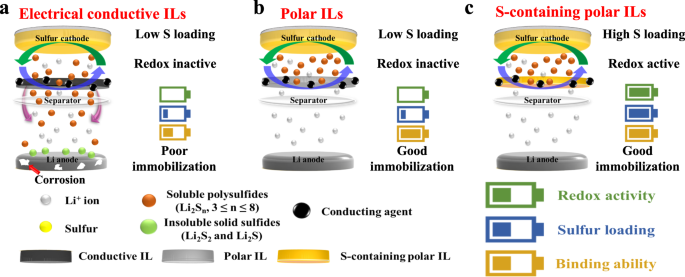リチウム硫黄電池は、新しい設計をすれば、その能力を最大限に発揮することができるのです。 With a new design, lithium-sulfur batteries could reach their full potential.
2023-01-06 アルゴンヌ国立研究所(ANL)
今回、研究者らは硫黄系電池の研究を発展させ、電池内に層を設けることでエネルギー貯蔵容量を増やすとともに、硫黄系電池の従来の問題であった腐食をほぼ解消することに成功しました。
この電池は、硫黄を含む正極とリチウム金属を含む負極の組み合わせで設計されている。この2つの電極の間に、電池の両端をイオンが通過できるようにするための物質である電解液が存在する。
初期のリチウム硫黄電池は、電解液に硫黄分(ポリサルファイド)が溶け込み、腐食の原因となるため、あまり性能が良くなかった。このポリサルファイドシャトリング現象は、電池寿命に悪影響を及ぼし、充電可能回数も減少させる。
このポリサルファイドのシャットリングを防ぐために、これまでの研究者は、正極と負極の間にレドックス不活性中間膜を配置することを試みた。レドックス不活性とは、電極のような反応を起こさない物質という意味である。しかし、この保護中間膜は重く、密度が高いため、電池の単位重量あたりのエネルギー貯蔵量が減少してしまう。また、シャットダウンも十分には抑えられない。このことが、Li-S電池の実用化における大きな障壁となっていた。
そこで研究者らは、多孔質の硫黄含有中間膜を開発し、試験を行った。実験室でのテストでは、この活性な中間膜を用いたLi-S電池は、不活性な中間膜に比べ初期容量が約3倍高くなった。さらに驚くべきことに、この活性な中間膜を用いたセルは、700回の充放電サイクルにわたって高い容量を維持した。
レドックス活性層をさらに研究するために、研究チームは、DOE Office of Scienceユーザー施設であるアルゴンヌのAdvanced Photon Source (APS)の17-BMビームラインで実験を行っています。この層を持つ細胞にX線ビームを照射して得られたデータから、中間膜の効果を確認した。
その結果、酸化還元活性中間膜はシャットリングを減らし、電池内の有害な反応を抑制し、電池の容量を増やしてより多くの電荷を保持し、より多くのサイクルを持続させることができることが確認された。APSのビームライン科学者であるWenqian Xuは、「これらの結果は、レドックス活性中間膜がリチウムイオン電池の開発に大きな影響を与える可能性があることを示しています」と述べています。とAPSのビームライン科学者Wenqian Xuは語っている。「この技術が日常生活の中で使われるようになるのに、あと一歩です」。
この研究に基づく論文は、『Nature Communications』誌の8月8日号に掲載された。
<関連情報>
- https://www.anl.gov/article/lithiumsulfur-batteries-are-one-step-closer-to-powering-the-future
- https://www.nature.com/articles/s41467-022-31943-8
レドックス活性層間戦略による高エネルギー非水系リチウム・硫黄電池の開発 Development of high-energy non-aqueous lithium-sulfur batteries via redox-active interlayer strategy
Byong-June Lee,Chen Zhao,Jeong-Hoon Yu,Tong-Hyun Kang,Hyean-Yeol Park,Joonhee Kang,Yongju Jung,Xiang Liu,Tianyi Li,Wenqian Xu,Xiao-Bing Zuo,Gui-Liang Xu,Khalil Amine & Jong-Sung Yu
Nature Communications Published:08 August 2022
DOI:https://doi.org/10.1038/s41467-022-31943-8

Abstract
Lithium-sulfur batteries have theoretical specific energy higher than state-of-the-art lithium-ion batteries. However, from a practical perspective, these batteries exhibit poor cycle life and low energy content owing to the polysulfides shuttling during cycling. To tackle these issues, researchers proposed the use of redox-inactive protective layers between the sulfur-containing cathode and lithium metal anode. However, these interlayers provide additional weight to the cell, thus, decreasing the practical specific energy. Here, we report the development and testing of redox-active interlayers consisting of sulfur-impregnated polar ordered mesoporous silica. Differently from redox-inactive interlayers, these redox-active interlayers enable the electrochemical reactivation of the soluble polysulfides, protect the lithium metal electrode from detrimental reactions via silica-polysulfide polar-polar interactions and increase the cell capacity. Indeed, when tested in a non-aqueous Li-S coin cell configuration, the use of the interlayer enables an initial discharge capacity of about 8.5 mAh cm−2 (for a total sulfur mass loading of 10 mg cm−2) and a discharge capacity retention of about 64 % after 700 cycles at 335 mA g−1 and 25 °C.



